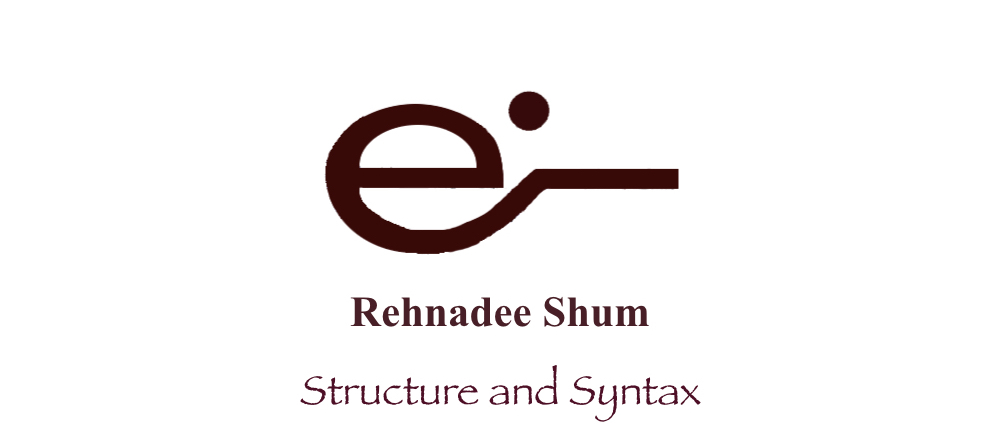Shum images come together to make Shum words which are also known as Shum Portraits and Shum Image-Portraits. They are portraits because the words are used to create meditation maps which are pictures. Within the structure of these portraits can be found meanings, instructions and description of mystic experiences and dimensional location.
This tutorial is a guide on how to read Shum and understand its structure. There are no sentences in Shum however its syntax lies in the convention of relating Shum Portraits to the 14 dimensions of phyiscal and mystic existence. You can practice Shum meditation even if you forgo learning the language rules. These rules are here for general knowledge and to set the standard for the creation of new Shum words. It is also important for Shum calligraphy.
- The Shum Images List
- Reading Shum
- Shum Portraits, Compendiums and Image Portraits
- Shum Syntax and the Dimension Count
The Shum Images List
The Shum Images List consists of 108 Shum images and is akin to the alphabet list of a language. A Shum Portrait is usually made up of at least two Shum images however there are also single Shum image words, some of which are Image-Portraits. When I first started learning Shum in the monastery in the early 90's there were 72 Shum images. These 72 images were created in the early days of Shum when Gurudeva first discovered the language in 1969. The 72 images consists of 18 primary images and 54 more images derived from the 18 primaries by adding conjunctions and diacritical marks, making for the 72 images. In the mid-90's Gurudeva added a further 36 images making for 108 images in total. Some of these 36 images are new conjunctions of the primary images and a few are new images that bare no resemblence to the 18 primaries.
Below are the 18 primary Shum images. The complete list of 108 Shum images can be found at this link Shum Images List.
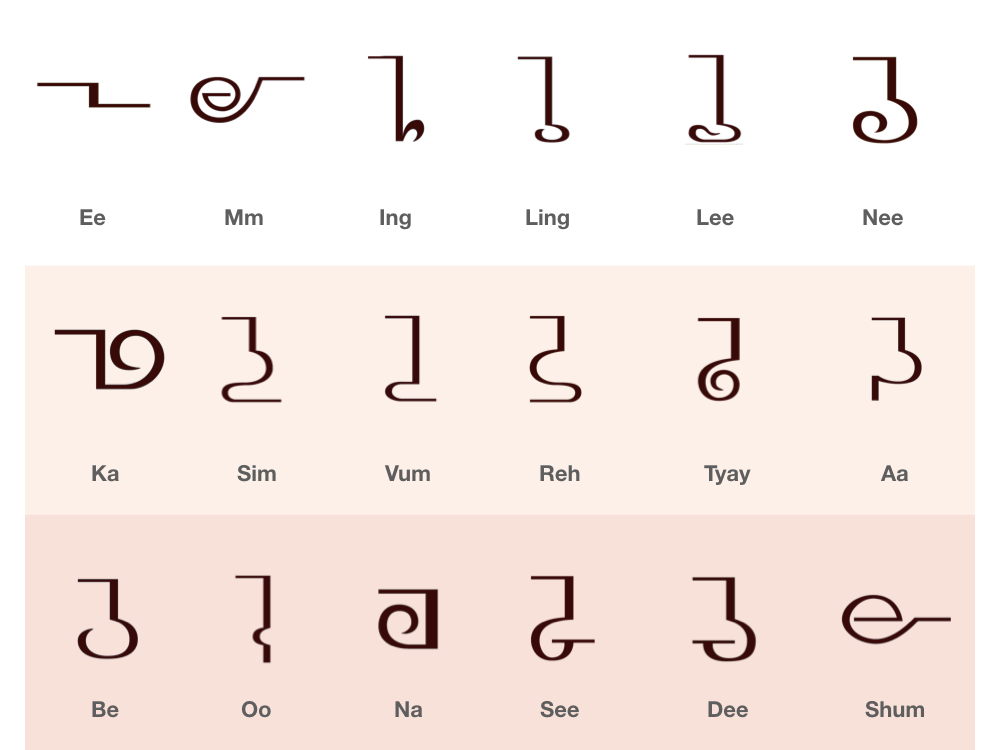 The 18 Primary Shum Images
The 18 Primary Shum Images
Reading Shum
Shum is easy to read. Once you can recognise all the Shum images you just have to put together the individual sound of each image to read a Shum Portrait. There is an example of a Shum Portrait further along in this tutorial that has six images. The images are Ing+Lee+Yu+Tyay+Lin+Reh so this Shum Portrait is simply read as IngLeeYuTyayLinReh. That's all there is to Shum phonetics.
There are 108 Shum images and the easiest way to read these images is to learn the conjunctive and diacritcal marks which are added to the primary images. Once you memorise the primary images and can identify the conjunctive and diacritical marks you can read the image. Following is a tutorial for reading Shum images.
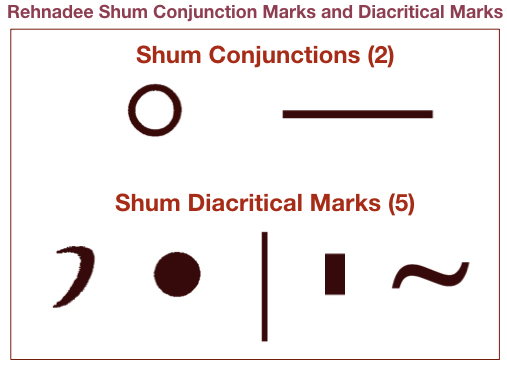
Above are the conjunction and diacritical marks used in Rehnadee Shum. The two conjuctions affect the sound and dimension count of the images they appears on. Only some of the diacritical marks affect the sound and dimension count of the images, the others only affect the dimension count. The tutorial below teaches how to read Shum images with these marks.
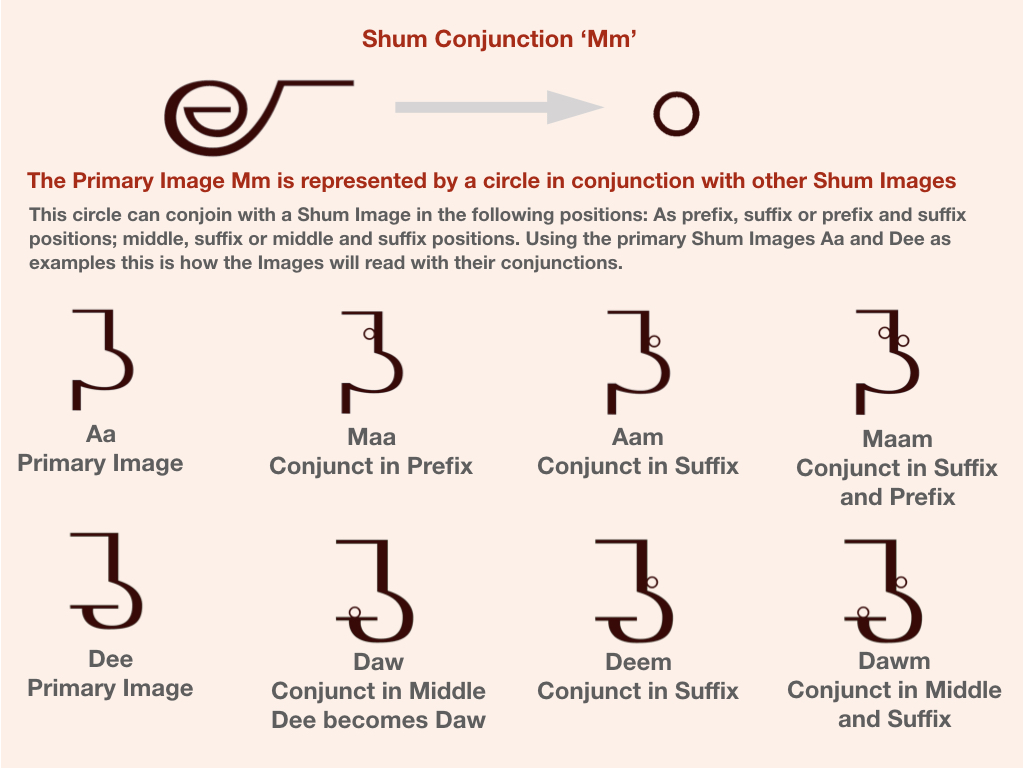
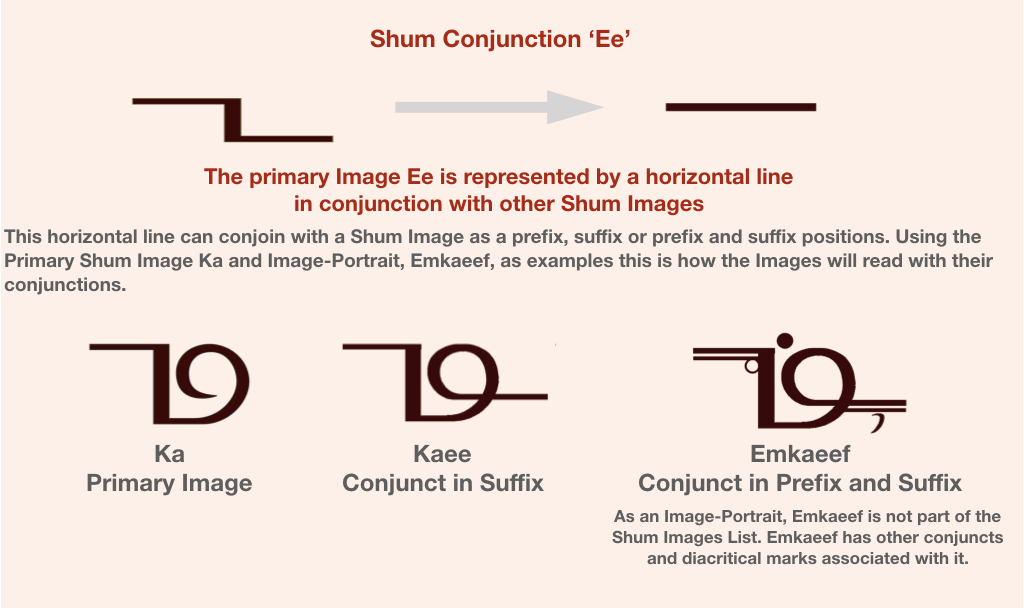
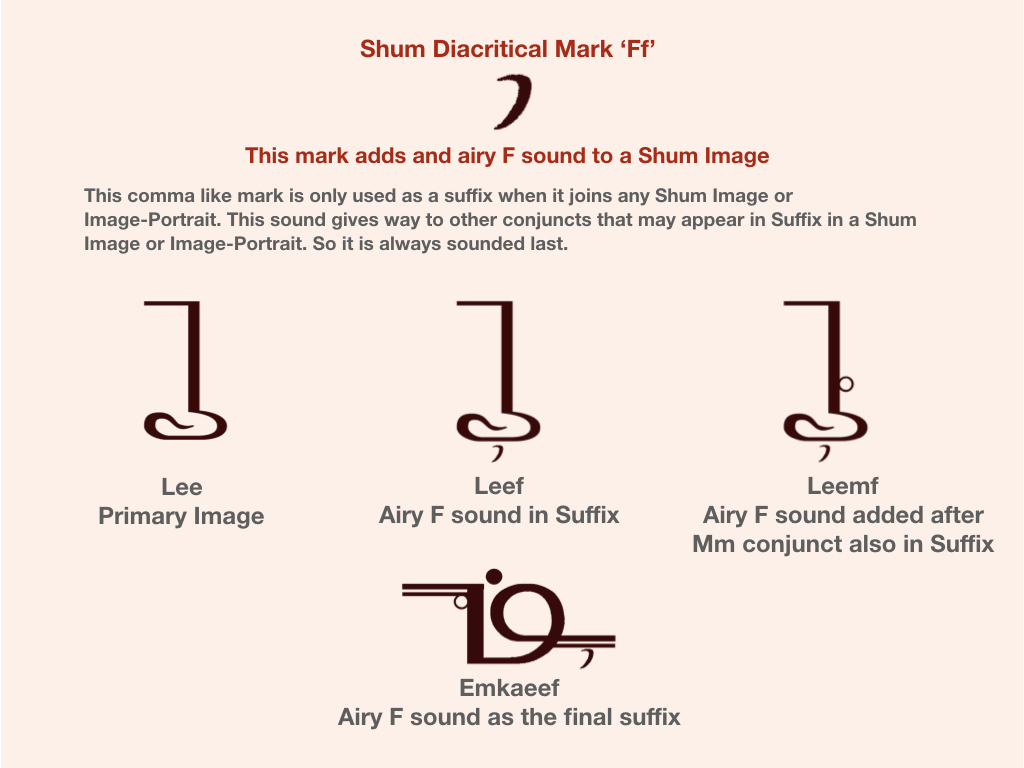
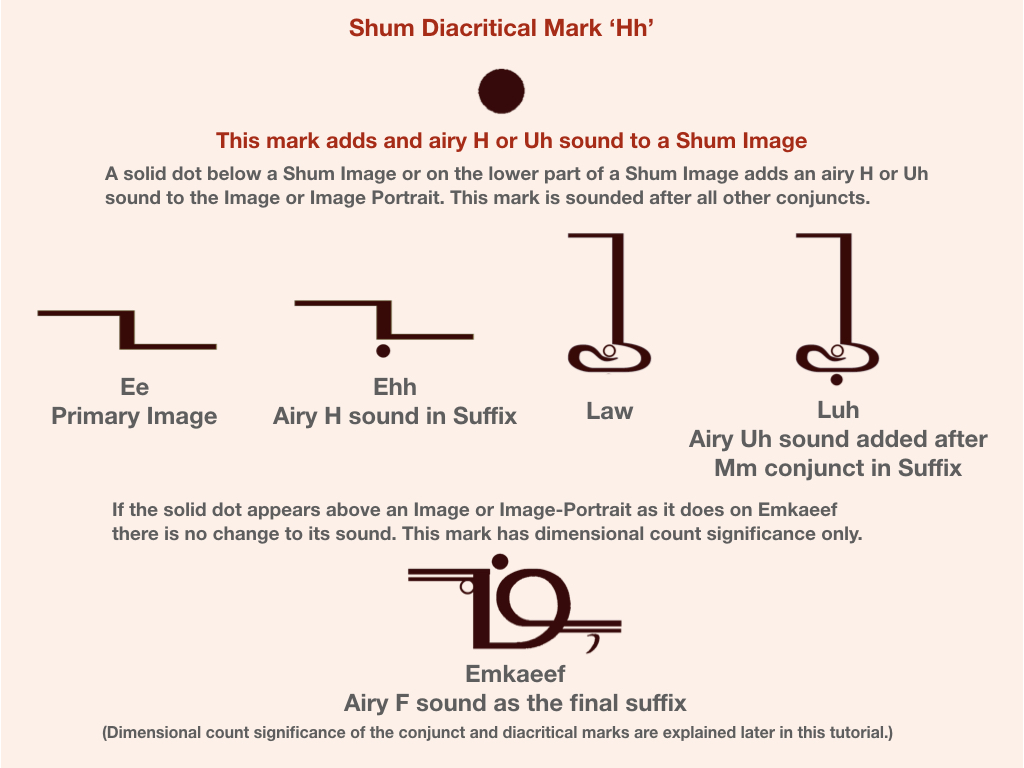
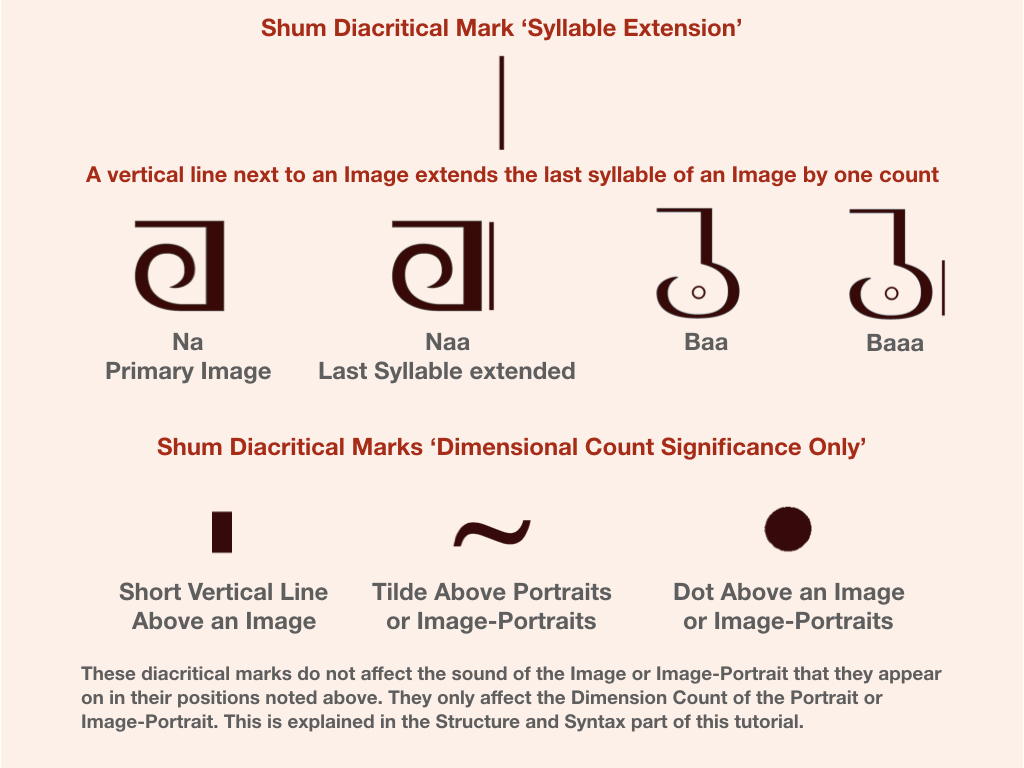
Portraits, Compendiums and Image-Portraits
A Shum Portrait is read by pronouncing the sound of each Shum image from left to right. For instance the Shum word for the experience of Spiritual Immersion is: Ing+Lee+Yu+Tyay+Lin+Reh and pronounced as such.
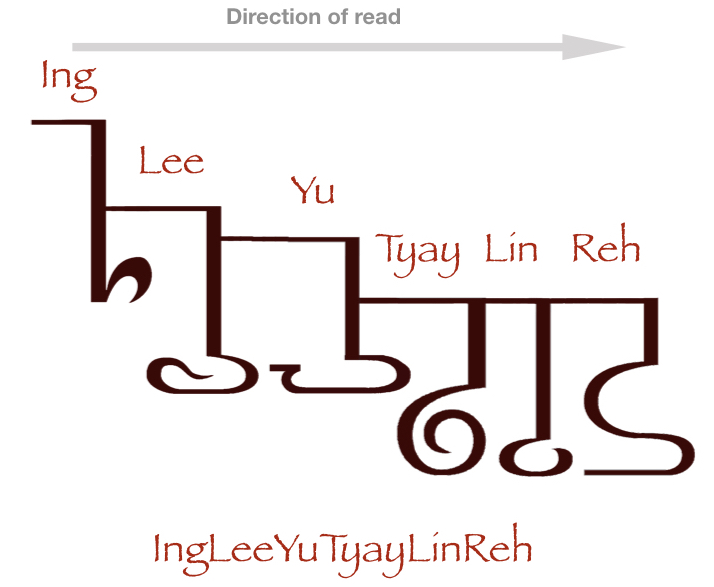
Shum Compendiums
IngLeeYuTyayLinReh is a Shum Portrait that contains 4 other words within it. A compendium of information to do with and leading up to the experience of Spiritual Immersion has been wrapped in the explanation of this Shum Portrait. This compendium is organised by starting with the longest Shum Portrait and then by dropping the left-most image one-by-one a new word is formed. Using the example above–IngLeeYuTyayLinReh, the compendium is as follows:
1. IngLeeYuTyayLinReh
2. LeeYuTyayLinReh
3. YuTyayLinReh
4. TyayLinReh
5. LinReh
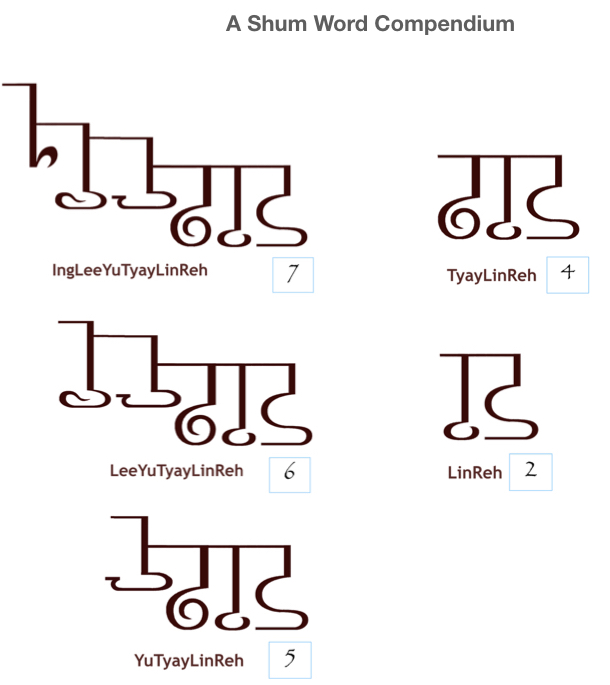
You can find in depth meanings of Shum Compendiums in the Shum Lexicon. This compendium convention of the Shum language always works by dropping the images from left to right, never the other way around (right to left). So IngLeeYuTyayLin isn't a word. The longest a Shum word can be is 10 images however this is rare. It is more common for Shum words to be from 7 images or less. The compendium convention of the Shum language was developed by my guru in the mid-90's as a more efficient way of packaging mystic experience with meditation techniques and related philosophy. When he first developed Shum in the 70's this convention wasn't there–so there would have to be a word for an experience, a different word for the meditation practice tied to it and another word for philosophical context.
Shum Image-Portraits
Shum Image-Portraits are Shum words that do not carry compendiums like Shum Portraits. They are used to name meditation goals such as Eemkaeef, mantras such as Aum, philosophical treatises such as Shummef or Shum names for meditators among other uses. As they do not carry a compendium Image-Portraits are stand alone Shum words whose combination of Shum Images are unique. Usually Image-Portraits have special shapes that make them stand out from Portraits. The list of Shum Image-Portraits can be viewed in the Shum Lexicon.
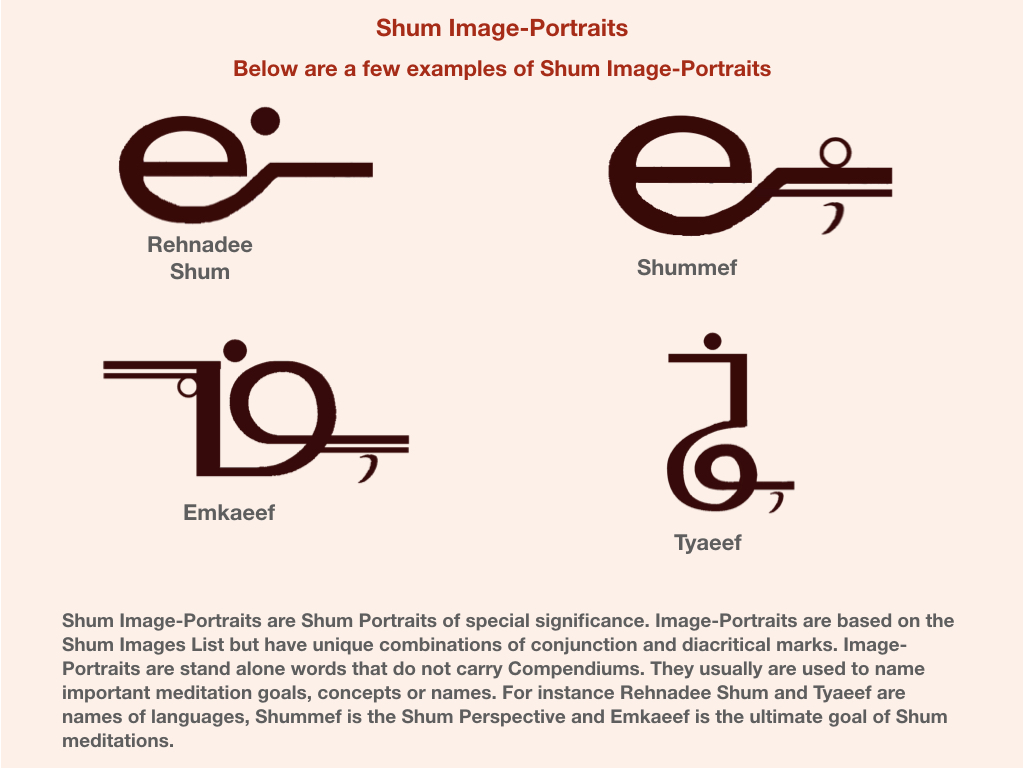
Shum Syntax and the Dimension Count
The Shum syntax organises words according to the 14 dimensions of existence. Tersely the first three dimensions encompass the realm of our physical life, dimensions four to six are mainly of the mind and its attunement to the soul and from the seventh dimension to the fourteenth–the realms of the soul.
As you study and practice Shum you will learn the relationship of the Shum Portrait's dimension count to its experience. The dimension count is an important aspect of the Shum language as it locates a mystic experience to the spiritual portal, chakra, it is connected to. In the Shum Lexicon every shum word will have its dimension count assigned to it so you don't have to know these rules to use Shum but it is a skill that needs to be mastered to create Shum words. The rules for counting the dimensions carried by a Shum image is given below followed by charts of the same. Adding the dimension count of all the images in a Shum Portrait gets the total which will be the dimension that the word is associated with. Below is a list of the Dimension Count Rules.
- Inherent Count: Every Shum image carries a count of at least one dimension. Of the primary 18 Shum images all carry a count of one dimension but for the images Ka, Aa, Oo and Shum, which carry two dimensions. A complete list of the inherent count each Shum image carries can be found in the following link: 108 Shum Images With Their Dimension Counts.
- Conjunct Count Addition 1: The Shum image 'Mm' is used in conjunction with other Shum images to add an 'Mm' prefix or suffix to the image. When used as a conjunction the 'Mm' image is represented by a circle. Each circle in prefix or suffix positions adds one dimension to the inherent count of the image. Conjunct count additions are fixed in the Shum Images List and in Shum Image-Portraits and cannot be used arbitrarily when creating Shum words.
- Conjunct Count Addition 2: When a circle appears in the middle of an image it transforms the last syllable of the image to Aa. This is a special conjunction of 'Mm' with other Shum images. This conjunction adds two dimension counts to the inherent count of a Shum image. This conjunction is fixed in the Shum Imges List and in Shum Image-Portraits and cannot be used arbitrarily when creating Shum words.
- Conjunct Count Addition 3: When a horizontal line is extended from anywhere but the stem of an image it adds a suffix or prefix of 'Ee' to the image. This conjunction adds one dimensional count to the inherent count of a Shum image. This conjunction is fixed in the Shum Images List and in Shum Image-Portraits and cannot be used arbitrarily when creating Shum words.
- Diacritical Count Addition 1: The diacritical mark–a vertical line next to an image–extends the sound of the last syllable of an image. It adds one dimension to the inherent count of a Shum image. This is a floating mark and can be added to Shum words as required for its dimensional count. When writing a Shum image with this diacritical mark in other languages an extra alphabet is added for the last syllable.
- Diacritical Count Addition 2: A comma-like mark below an image adds a suffix with an airy 'Ff' sound to a Shum image. It increases the inherent count of a Shum image by three dimensions. This diacritical mark is fixed in the Shum Images List and in Shum Image-Portraits and cannot be arbitrarily added to Shum words.
- Diacritical Count Addition 3: A dot anywhere around an image except above it adds an airy suffix 'Huh' or 'Hh' to a Shum image. This diacritical mark increases the inherent count of a Shum image by three dimensions. This is a diacritical mark fixed in the Shum Images List and Shum Image-Portraits and cannot be arbitrarily added to Shum words.
- Diacritical Count Addition 4: A dot above an image adds 5 dimensions to the Shum image. This diacritical mark does not affect the sound of the image it is on. This is a floating diacritical mark, meaning, it can be added to any Shum image as required by the dimension count requirements of a Shum word. When writing a Shum word in other languages a semi-colon ; is used to represent this diacritical mark.
- Count Limiter Diacritical: A short vertical line above an image is a dimension count limiter. It reduces the dimension count of an image to one and ignores other conjucts, diacritical marks and the inherent count of the image. It too doesn't affect the sound of the image it is on. This is a floating diacritical mark that can be used as necessary for the dimensional count needs of a Shum word. When writing a Shum word in other languages this count limiter is represented by a period '.' (fullstop).
- Count Nullifier Diacritical: A tilde, ~ when seen above a Shum word means the word carries no dimension count. This diacritical mark is usually used to name Shum philosophical treatise or Shum word lists. When writing Shum words in other languages a tilde is used after the word to represent this diacritical mark.
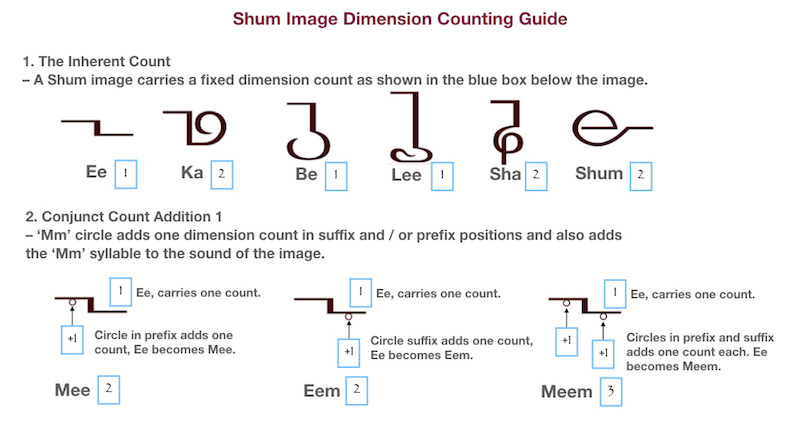
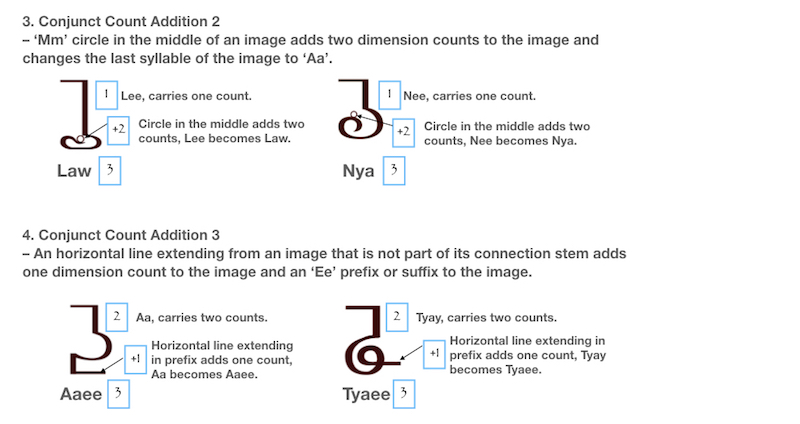
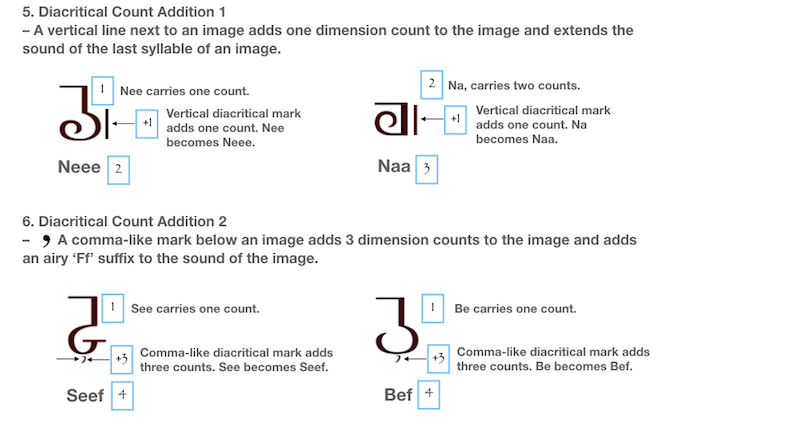
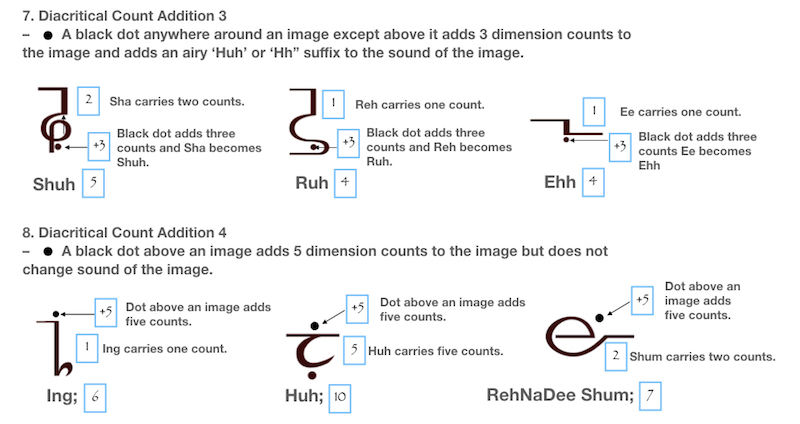
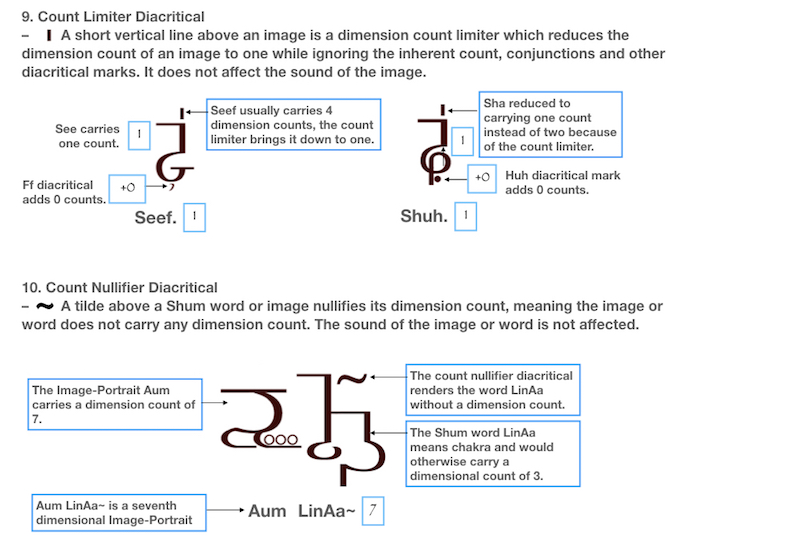
A complete list of the Dimension Count of all 108 Shum Images is at this link: 108 Rehnadee Shum Images.
Using the example of the word IngLeeYuTyayLinReh, the dimension count of this Portrait is tabulated as follows:
- The Images Ing, Lee, Yu, Lin and Reh carry an Inherent Dimension Count of 1 each.
- The Image Tyay carries an Inherent Dimension Count of 2.
- When totalled it is 1+1+1+2+1+1=7
- Therefore IngLeeYuTyayLinReh is a Seventh Dimensional Shum Portrait. It names the experience of Spiritual Immersion.
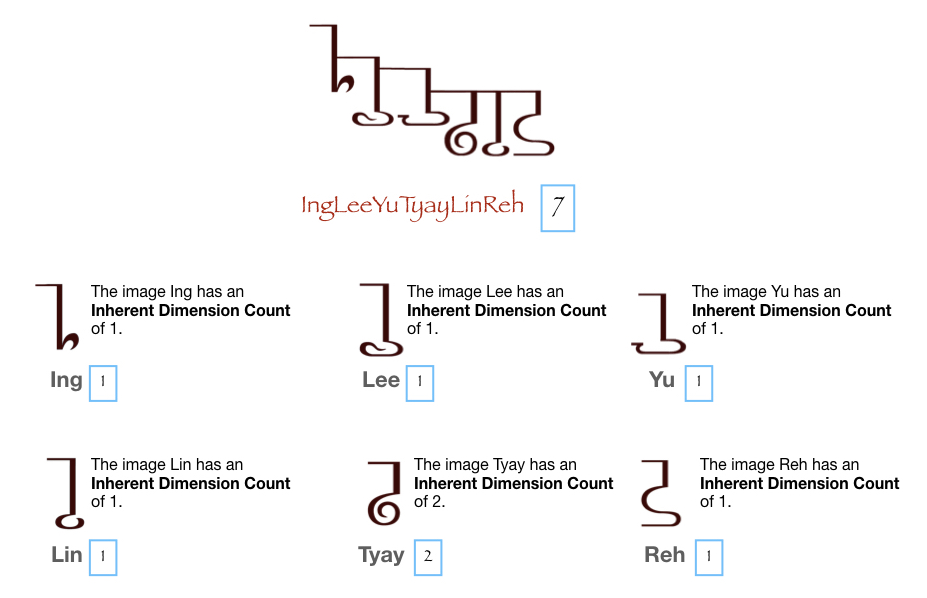
The dimension count of all the Shum words in ShumSanctuary.com will appear in a blue box on the bottom right of Shum Portraits. In Shum meditations this information is essential for locating the point of focus neccessary to experience the Portrait. RehNaDee Shum's Dimension Count Rules are necessary knowledge for Shum Guides and Shum Masters to create new Shum words.
The structure of Shum images and words and its special compendium rules apply to all dialects of Shum language however the Dimension Count Rules are specific to Rehnadee Shum.


